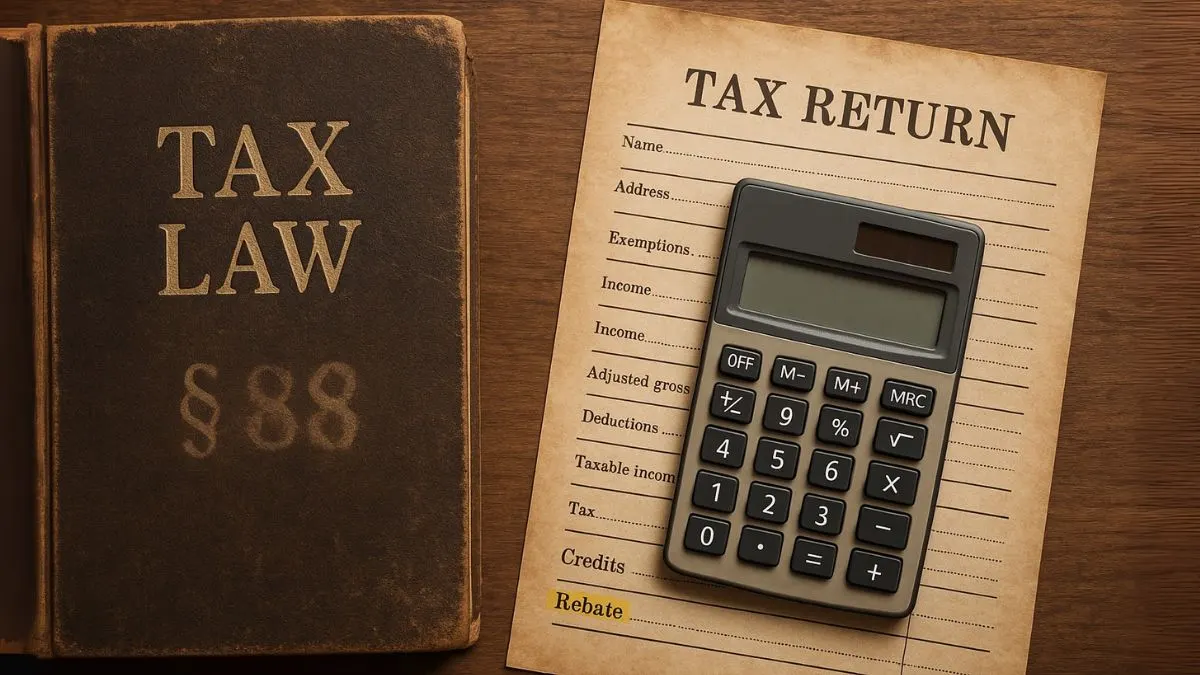
Tax laws in India have gone through multiple changes over the years. While some sections are still in force, others have been replaced or withdrawn. One such provision was Section 88 of the Income Tax Act, which once offered significant rebates to individual taxpayers and Hindu Undivided Families (HUFs). Though it is no longer applicable in its original form (as it was replaced by Section 80C from 2005 onwards), many still search for its relevance and historical role in tax rebates.
Section 88 was important because it allowed individuals & HUFs to reduce their tax burden by investing in specific instruments. It encouraged savings by linking them with tax benefits, thereby promoting financial discipline among taxpayers. Let us understand in detail what this section was, who could claim it, and why it continues to be an important part of India’s tax history.
What Was Section 88 of the Income Tax Act?
Section 88 was a provision that allowed taxpayers to claim a rebate on certain qualifying investments. Unlike deductions under today’s Section 80C, which reduce the taxable income, the rebate under Section 88 directly reduced the tax payable.
This rebate was available to:
- An assessee, being an individual, or a Hindu Undivided Family (HUF).
- Only those who had made specified investments or payments listed under the section.
In simple terms, if you paid premiums for life insurance, contributed to a provident fund, or invested in specific government schemes, you could get back a portion of your tax liability through this rebate."
Investments Covered Under Section 88
Section 88 provided rebates on a wide range of investments, with the objective of promoting long-term financial savings among individuals. Some of the most common eligible contributions were:
- Rebate on life insurance premia – Any amount paid to effect or to keep in force an insurance on the life of persons specified in sub-section (4). This included self, spouse, and children.
- Contribution to Provident Fund – Payments to recognized or public provident funds were eligible for rebate.
- Contribution to certain government schemes – For example, National Savings Certificates (NSC).
- Pension contributions – Some notified pension funds were also included.
In essence, Section 88 rewarded taxpayers for investing in safe, long-term, & government-backed instruments.
Calculation of Rebate under Section 88
The rebate under Section 88 worked differently from deductions. Here’s how it was calculated:
- A taxpayer could claim 20% rebate on eligible investments up to a certain limit.
- For example, if someone paid ₹10,000 in life insurance premiums, they could reduce their tax liability by ₹2,000 (20% of 10,000).
This direct reduction in tax liability made Section 88 highly attractive. It effectively gave taxpayers a chance to lower their final tax payment while simultaneously building savings.
Also Read: Tax-Free Life Insurance Benefits
Eligibility for Rebate
The eligibility was simple:
- Every person who has a total income that exceeds the exemption limit must file an ITR for the previous year.
- If such a person was an individual or HUF, they could claim rebate under Section 88 by making qualifying investments.
- Salaried individuals, professionals, and self-employed persons could all take advantage of this rebate, provided they met the conditions.
This provision encouraged wide participation in financial instruments & laid the foundation for tax-saving habits that continue even today under Section 80C."
Difference Between Section 88 and Section 80C
Many taxpayers confuse Section 88 with Section 80C, but there are clear differences:
- Section 88 offered a rebate on tax payable, while Section 80C offers a deduction from gross total income.
- Under Section 88, the benefit was a fixed percentage (generally 20%), whereas under Section 80C, you save tax depending on your income slab.
- Section 88 was applicable before 1st April 2005, and thereafter Section 80C replaced it as part of tax reforms.
This change simplified tax provisions and consolidated multiple rebates & deductions under one section (80C).
Also Read: Bima Sugam Portal – One Click to Access All Your Insurance Policies Online
Importance of Section 88 in Indian Tax History
Though it is no longer in force, Section 88 holds significance because it shaped the early framework of tax incentives for savings. By offering rebates on life insurance, provident funds, and government securities, it encouraged taxpayers to invest in safe financial products.
It also acted as a relief mechanism by directly reducing the tax liability, giving immediate financial relief to small & middle-class taxpayers. Many taxpayers still recall how Section 88 helped them save money on tax while planning for their future.
Criticism and Withdrawal of Section 88
While Section 88 was beneficial, it had certain shortcomings:
- The rebate was often considered complex, as different investments had different rules.
- The system did not differentiate much between income groups.
- With the need for simplification, the government introduced Section 80C in 2005, replacing Section 88 and consolidating tax-saving provisions under one head.
This move was appreciated as it made tax planning simpler and more uniform for taxpayers.
Also Read: The ₹1.5 Lakh Tax-Saving Secret Most Taxpayers Miss!
Relevance Today
Even though Section 88 is not applicable today, many people still search for it because:
- Old tax records & documents mention it.
- Senior taxpayers who filed returns before 2005 remember it as a major rebate section.
- Understanding Section 88 helps in knowing the evolution of tax laws in India.
For present-day taxpayers, the equivalent benefit is now covered under Section 80C, which allows deductions up to ₹1.5 lakh on specified investments.
Conclusion
Section 88 of the Income Tax Act was once a cornerstone for individual tax planning in India. It offered rebates on life insurance premia, provident fund contributions, and other savings instruments. For an assessee, being an individual, or a Hindu Undivided Family, certain rebates were allowed to effect or to keep in force an insurance on the life of persons specified in sub-section (4). It was a powerful tool that provided relief on taxes & encouraged financial discipline among taxpayers.
Though Section 88 was withdrawn and replaced with Section 80C, its legacy remains. It was one of the earliest steps towards creating a tax regime that encouraged savings, investments, and security for families.
👉 Want to know the best way to maximize your tax savings under today’s provisions like Section 80C, 80D, and others? Check out our services at Callmyca.com, where expert Chartered Accountants help you save taxes legally and smartly.











